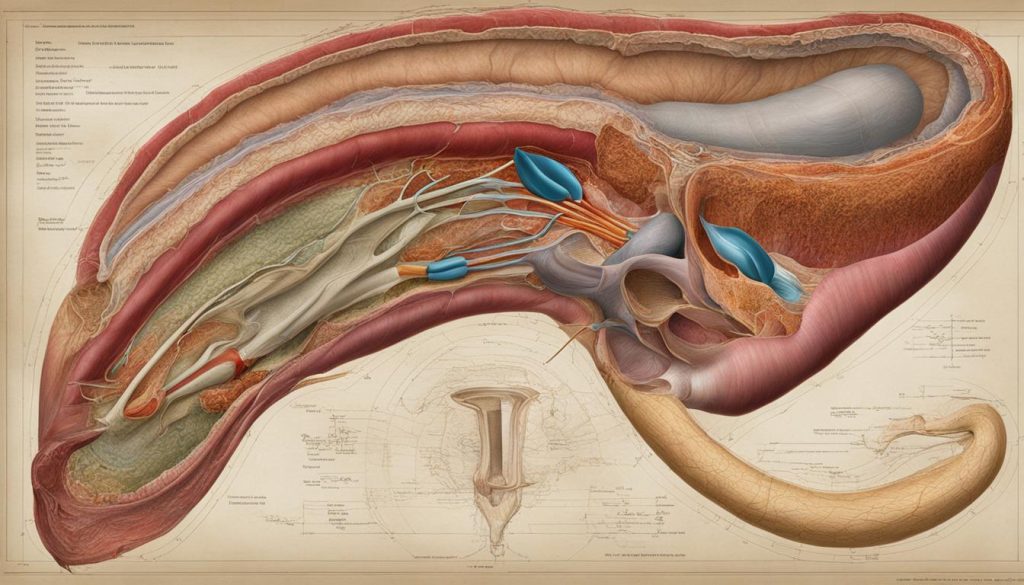Have you ever wondered why the penis is shaped the way it is? It turns out that there’s a fascinating scientific explanation behind this unique shape. In this article, I’ll explore the intriguing reasons behind the mushroom-shaped penis and the theories that support it.
But first, let’s take a closer look at the penis itself. The shape of the penis varies among individuals, but one common feature is the mushroom-shaped head. This distinctive shape has sparked curiosity and led researchers to delve deeper into its significance.
Key Takeaways:
- The mushroom shape of the penis is believed to have evolved as an adaptation to maximize reproductive success.
- According to the semen displacement theory, the ridge on the penis acts as a tool to scoop out rival sperm from the vagina.
- Research has confirmed that the mushroom-shaped head of the penis can effectively displace prior sperm.
- Alternative theories and factors, such as pleasurable sensations and individual variations, contribute to penis shape diversity.
- There are ongoing debates and unanswered questions in the scientific community regarding penis morphology.
The Science Behind the Mushroom Shape
When it comes to human penile anatomy, the structure and morphology of the penis are fascinating topics of study. The mushroom shape, with its pronounced coronal ridge, is an intriguing feature that has long puzzled researchers. Understanding the science behind the mushroom shape requires delving into the realms of penile aesthetics, development, and evolutionary biology.
The penile structure is a complex interplay of various tissues, including erectile tissue, blood vessels, and skin. During penile development, hormonal signals and genetic factors shape the growth and formation of the penis. This process determines not only the length and girth but also the overall shape. The mushroom shape, with its wider head and narrower shaft, is influenced by the growth patterns and tissue distribution during development.
From an evolutionary perspective, the mushroom shape is believed to have emerged as an adaptation to increase male reproductive success. The pronounced coronal ridge and wider head are thought to aid in semen displacement, which is the process of removing a previous competitor’s sperm from the female reproductive tract. This adaptation gives a male a higher chance of achieving paternity by substituting his semen for that of rivals.

Testing the Semen Displacement Theory
In order to put the semen displacement theory to the test, researchers at the State University of New York conducted a series of experiments using latex penises and model vaginas. These experiments aimed to investigate the effectiveness of the mushroom-shaped ridge in semen removal and explore the importance of thrusting depth.
The researchers found that the ridge around the head of the penis played a crucial role in semen removal. In just one thrust, the ridge was able to scoop out more than 90% of a semen substitute used in the experiment. In comparison, a penis without a ridge only managed to remove 35% of the substitute. This finding provides evidence that the mushroom shape of the penis aids in effective semen displacement.
Furthermore, the depth of thrusting was found to be an important factor in clearing the vagina of prior sperm. The researchers observed that deeper thrusting allowed for more thorough semen removal, potentially increasing the chances of successful reproduction. These findings support the idea that the shape and mechanics of the penis have evolved to maximize a male’s reproductive success.
Overall, the experiments conducted by the State University of New York provide compelling evidence in support of the semen displacement theory. The use of latex penises and model vaginas allowed researchers to simulate real-life scenarios and draw meaningful conclusions about the role of the mushroom shape in semen removal. These findings contribute to our understanding of evolutionary adaptations and the complex dynamics of reproductive biology.
The Role of Sexual Competition
In the realm of sexual reproduction, competition for paternity is a driving force in shaping male reproductive success. The mushroom-shaped penis, with its unique ability to displace the ejaculate of sexual rivals, plays a crucial role in this ongoing battle for reproductive dominance.
Sexual rivalries have long been observed in various animal species, where males use a variety of strategies to increase their chances of siring offspring. This includes mechanisms such as sperm competition and mate guarding. The mushroom shape of the penis, with its pronounced coronal ridge, is an adaptation that aids in ejaculate displacement, allowing the male to remove the semen of previous mates and replace it with his own.
Competition for Paternity
The penis’s ability to remove a previous lover’s semen from the female reproductive tract gives the male a significant advantage in the competition for paternity. By clearing the way for their own reproductive material, males can increase their chances of fathering offspring and securing their genetic legacy.
This adaptation may have been particularly advantageous during times of higher sexual competition when multiple males were vying for the same female. By ensuring the removal of rival semen, males with a mushroom-shaped penis could establish themselves as the dominant reproductive partner.

Ejaculate Displacement and Reproductive Success
The role of sexual competition in driving the evolution of the mushroom-shaped penis highlights the importance of reproductive success in shaping male reproductive anatomy. Those males who are more successful in removing the ejaculate of their rivals have a higher chance of fathering offspring and passing on their genetic traits.
While the exact mechanisms and nuances of sexual competition are still the subject of ongoing research and debate, the presence of the mushroom-shaped penis in various species is a testament to the significant role that competition for paternity plays in shaping male reproductive strategies.
Alternative Explanations
When it comes to the shape of the penis, there are alternative explanations beyond the semen displacement theory. While it is believed that the mushroom shape aids in maximizing reproductive success, other factors such as penile aesthetics and pleasure during sex also play a role.
Some experts propose that the unique shape of the penis is related to the pleasurable sensations experienced by both men and women during sexual activity. The ridge and shape of the head may provide added stimulation and enhance sexual pleasure. Additionally, individual sexual preferences and variations in penile anatomy contribute to the diverse range of penile shapes.
Penile Aesthetics and Sexual Preferences
Penile aesthetics, which refer to the visual appearance of the penis, can influence sexual preferences. Just as individuals have different preferences for body types and facial features, they may also have preferences for certain penile shapes. There is a wide range of variation in penile anatomy, including size, girth, angle, and circumcision status.
It’s important to note that there is no standard or “normal” shape for a penis. What matters most is that all penises are capable of performing their intended functions and providing sexual pleasure. Whether it’s a mushroom shape, pencil shape, sausage shape, or cone shape, each penis is unique and suited to the individual it belongs to.
Other Penis Shapes
Penises come in various shapes and sizes, each with its own unique characteristics. While the mushroom shape is commonly known, there are other distinct penis shapes that exist. One such shape is the pencil shape, characterized by a long and slender shaft. This shape may offer different sensations and experiences during sexual activity.
Another interesting shape is the sausage shape, which is characterized by a cylindrical and uniform thickness throughout the shaft. This shape may provide a different aesthetic appeal and may also impact sexual experiences. Additionally, some penises have a cone shape, with a tapered head and a gradually narrowing shaft. This shape can result in unique sensations and may offer a different visual appearance during sexual encounters.
It’s important to note that penis variety is influenced by individual genetics and other factors such as size, girth, angle, and circumcision. These variations are normal and do not affect the functionality or pleasure of sexual experiences. Ultimately, the shape of a penis is unique to each individual and should be embraced and celebrated for its diversity.
Exploring Different Shapes
While the mushroom shape is widely recognized, exploring different penis shapes can add excitement and variety to intimate experiences. Whether it’s the pencil shape, sausage shape, or cone shape, each shape offers its own unique attributes and potential sensations.
Some may prefer the slim and elongated pencil shape, while others may find the uniform thickness of the sausage shape more appealing. The tapered and gradually narrowing shaft of the cone shape can create a different visual and physical experience.
It’s important to remember that there is no “normal” or standard shape for a penis. The diversity of penis shapes is what makes each individual unique. Embracing and exploring the variety of shapes can contribute to a more fulfilling and enjoyable sexual journey for both partners.
Debates and Unanswered Questions
As fascinating as the semen displacement theory is, it is not without its opponents. Some experts argue that there may be other factors at play when it comes to the mushroom shape of the penis. They believe that the theory oversimplifies the complex nature of sexual reproduction.
One of the loopholes in the semen displacement hypothesis is the limited lifespan of sperm. Sperm can survive in the female reproductive tract for only a few days, which raises questions about the practical significance of semen displacement. Additionally, the timing of ovulation plays a crucial role in determining a woman’s fertile period, further complicating the theory.
In order to fully understand the evolutionary causes and implications of penis morphology, more research and investigation are needed. Scientists continue to explore alternative theories and gather evidence to support or refute the semen displacement theory. It is a fascinating area of study that raises many questions and sparks debates among experts in the field.
FAQ
Why is the penis mushroom-shaped?
The mushroom shape of the penis is believed to have evolved as an adaptation to female infidelity and competition for paternity. The ridge around the head of the penis helps in semen displacement, allowing the male to increase his chances of fathering offspring.
What is the science behind the mushroom shape?
The mushroom shape is a result of human penile anatomy, penile structure, and phallic morphology. It is thought to have evolved through the process of natural selection to maximize reproductive success.
How was the theory tested?
Scientists used latex penises and model vaginas to simulate sexual intercourse. The experiments showed that the ridge around the head of the penis can effectively scoop out a significant amount of prior semen, supporting the semen displacement theory.
What role does sexual competition play?
Competition for paternity and male reproductive success are believed to have driven the evolution of the mushroom-shaped penis. By displacing the semen of other males, a male can increase his chances of fathering offspring.
Are there alternative explanations for the penis shape?
Some experts propose that the shape may also be related to pleasurable sensations felt by both men and women during sex. Additionally, sexual preferences and individual variations in penile anatomy contribute to the diversity of penis shapes.
What are some other penis shapes?
Besides the mushroom shape, penises come in various shapes and sizes, including the pencil, sausage, and cone shapes. These variations are influenced by individual genetics and other factors such as size, girth, angle, and circumcision.
Are there debates and unanswered questions about the theory?
Yes, there are ongoing debates in the scientific community, and some experts argue that there may be other factors at play. Loopholes, such as the limited lifespan of sperm and the timing of ovulation, raise questions about the practical significance of semen displacement.


